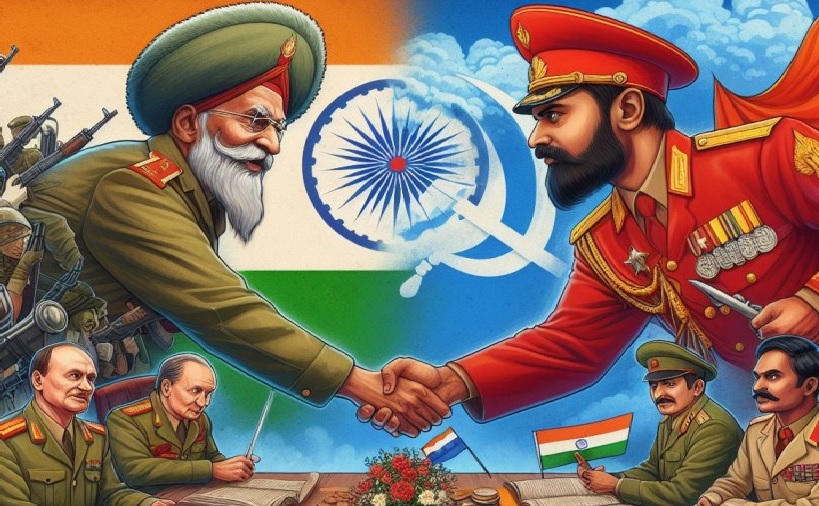What Sovient Union did for India : A Comprehensive Analysis of Impact on India

Relation Between India And Soviet Union
The relationship between India and the Soviet Union has been one of the most significant bilateral partnerships in the post-World War II era. Spanning several decades, this alliance shaped India's socio-economic, political, and strategic landscape. From the early years of independence to the dissolution of the Soviet Union, the ties between the two nations evolved through various phases, leaving an indelible mark on India's trajectory. This article delves into the multifaceted relationship between India and the Soviet Union, examining key events, milestones, and their lasting implications.
1947-1960: Formative Years of Friendship
In the aftermath of independence in 1947, India faced numerous challenges, including economic reconstruction and geopolitical uncertainties. The Soviet Union emerged as a staunch supporter of India's nation-building efforts. One of the earliest manifestations of this support was the signing of the Treaty of Friendship between India and the USSR in 1971, which laid the foundation for future cooperation.
The Soviet Union extended significant assistance to India's industrialization and infrastructure development projects during this period. Notable projects include the Bhilai Steel Plant, the Hindustan Aeronautics Limited (HAL), and the establishment of the Indian Institutes of Technology (IITs). Additionally, the USSR provided crucial military aid to India, particularly during the 1962 Sino-Indian War and the 1965 Indo-Pakistani War, further cementing the strategic partnership between the two nations.
1961-1971: Strengthening Ties Amidst Global Turmoil
The 1960s witnessed a deepening of Indo-Soviet cooperation, characterized by increased economic assistance and technological collaboration. Soviet support played a pivotal role in India's Green Revolution, aimed at achieving self-sufficiency in food production. Moreover, the USSR became a key supplier of defense equipment to India, including aircraft, tanks, and submarines.
During the Indo-Pakistani War of 1971, the Soviet Union unequivocally supported India's stance on the Bangladesh Liberation War, providing diplomatic backing and military assistance. The signing of the Indo-Soviet Treaty of Peace, Friendship, and Cooperation in August 1971 further solidified the alliance, marking a significant milestone in bilateral relations.
1972-1985: The Golden Era of Cooperation
The 1970s and 1980s marked a period of unparalleled cooperation between India and the Soviet Union, characterized by extensive economic, military, and technological collaboration. The signing of the Treaty of Peace, Friendship, and Cooperation laid the groundwork for enhanced strategic ties and mutual support on regional and global platforms.
Economic assistance from the Soviet Union bolstered India's industrial sector, with the establishment of heavy industries, infrastructure projects, and scientific research institutions. The Soviet Union also provided crucial support to India's space program, culminating in the launch of the Aryabhata satellite in 1975.
On the defense front, the Soviet Union emerged as India's principal arms supplier, accounting for a significant portion of India's defense acquisitions. Joint defense production ventures, such as the manufacture of MiG aircraft and T-72 tanks, underscored the depth of military cooperation between the two nations.
1986-1991: Winds of Change and New Realities
The late 1980s witnessed a shifting geopolitical landscape, marked by the onset of perestroika and glasnost in the Soviet Union under the leadership of Mikhail Gorbachev. The winds of change in Moscow reverberated across the globe, impacting the dynamics of Indo-Soviet relations.
Despite the domestic upheavals in the Soviet Union, India and the USSR continued their strategic partnership, albeit amidst evolving challenges. Economic reforms in India and the collapse of the Soviet Union in 1991 ushered in a new phase in bilateral relations, characterized by adjustments to the changing global order.
Post-1991: Transition and Continuity
The disintegration of the Soviet Union posed significant challenges for India, necessitating a recalibration of its foreign policy priorities. While the demise of the USSR marked the end of an era in Indo-Soviet relations, it also paved the way for the transformation of the bilateral partnership into a more diversified and pragmatic engagement.
India's engagement with Russia, the successor state of the Soviet Union, has remained steadfast, albeit within the context of a rapidly evolving global landscape. Strategic cooperation in defense and energy sectors continues to form the bedrock of Indo-Russian relations, with both countries exploring new avenues for collaboration in emerging domains such as cybersecurity, space exploration, and nuclear energy.
Conclusion:
The relationship between India and the Soviet Union, spanning several decades, stands as a testament to the enduring bonds of friendship and cooperation between the two nations. From the formative years of independence to the contemporary era of strategic partnership, Indo-Soviet relations have weathered numerous challenges and transitions, leaving an indelible imprint on India's socio-economic, political, and strategic landscape. As India navigates the complexities of the 21st century, the legacy of the Indo-Soviet alliance continues to shape its foreign policy outlook and global aspirations.



